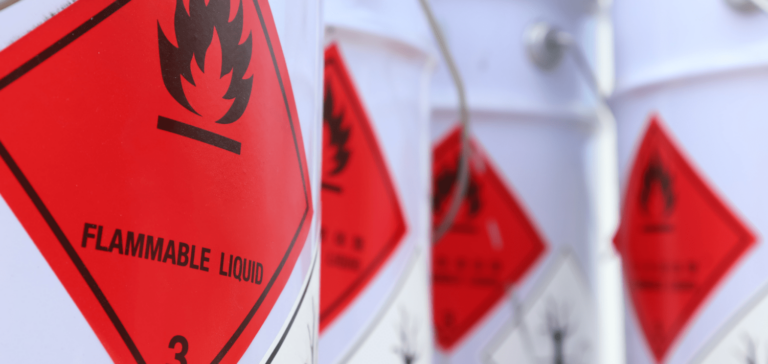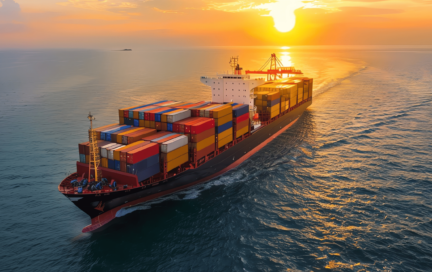Before we go into details on how to ship hazardous materials, one needs to understand that different types of cargo require different measures for transportation. For instance, non-perishable products like apparel, toys and home decor products can be easily packed up and shipped by air or sea without having to worry too much about the handling of the cargo. While these products may require less care, they also yield a lower profit margin. If apparel shipping is on the far left end of the spectrum of cargo-sensitivity, in terms of ease-of-care, hazardous and dangerous goods shipping are on the far right end. Great lengths must be taken to ensure its safe transport. First, let’s define what hazardous and dangerous goods are, then explore the five steps necessary to ship them safely.
Hazardous or dangerous goods can be defined as materials or items with inherent hazardous properties which if not properly controlled, can present a potential hazard to the health and well-being of all living organisms and the safety of the environment.
Dangerous goods can be solids, liquids or gases. They can be hot or cold, pungent or odorless, transparent or colored and their hazardous effects can be anything from minimal to fatal. They may be pure chemicals, mixtures of substances, manufactured products or individual articles on their own.
Hazardous goods are classified and identified according to the nature of the hazard such as flammable, inflammable, poisonous, explosive, etc. The classifications as shown in the chart below.
With so many classes, sub-classes and divisions, shipping the various types of hazardous goods around the world can be quite tricky.
Below are the 5 tips to guide you on dangerous goods shipping.
1. Know your hazardous goods
If you are a shipper or carrier of hazardous materials, it is crucial for you to know and understand the nature of the goods you are handling, the inherent risks it possesses and the regulations surrounding its transportation.
Even seemingly harmless products like table tennis balls, nail polish, paint, and perfumes are listed as hazardous materials. For shipping paint, for example, hazardous transport regulations are applicable.
The hazardous effects of some these goods may include acidic/caustic burning of skin tissue, the emission of flammable and/or toxic fumes whereas some products can be corrosive to metals and other materials; others can be explosive in nature or when exposed to sources of heat. Certain goods can be harmful to the environment if not contained properly and others can react dangerously to water.
Shipping Batteries
Daily items of use such as lithium batteries need to be handled carefully and the differentiation between lithium metal and lithium-ion batteries need to be understood. Lithium batteries have been the subject of many discussions due to the many incidents that have happened in its transportation.
Shipments of lithium batteries need to meet following Special Provisions 188 of the IMDG Code:
- Lithium content / watt-hour rating for cells
- Aggregate lithium content / watt-hour rating for batteries
- Manufacturing and testing
- Package
- When installed in equipment
- Package marking
- Drop test of package
- Gross mass of packages
The shipper of these hazardous materials must be aware of all the facts related to their product and must display these facts using documents, labels, etc.
2. Follow the dangerous goods regulations
The transportation of dangerous goods is a highly regulated process as there are human lives and property involved at all stages of transport and in all modes.
Each mode of transport has its own set of regulations and whether you are a shipper or carrier, you need to be aware of what this entails.
There are several restrictions, regulations, processes involved in transporting hazardous materials and these vary greatly from country to country and even from state to state within the same country.
The transportation of hazardous materials by sea is governed and regulated by the The International Maritime Dangerous Goods Code or IMDG Code, which is the internationally accepted regulation for the safe transportation of dangerous goods and hazardous materials by sea. The IMDG Code is intended to protect the ship’s crew, prevent marine pollution by hazardous materials and ensure safe transportation.
The implementation of the code is mandatory. It contains advice on terminology, packaging, labeling, placarding, markings, stowage, segregation, handling, and emergency response in relation to carrying dangerous goods by sea. The 2014 Edition of the IMDG code Incorporating Amendment 37-14, which became mandatory on 1 January 2016, is currently the latest edition.
The Hazardous Materials Transportation Act (HMTA) of 1975 was passed after a 707-cargo jet carrying hazardous materials crashed in 1973. This crash brought to the fore the general lack of compliance with existing requirements ostensibly due to fragmentation of the regulatory authorities implementing the requirements, the complexity of the regulations itself and a lack of industry familiarity with the Federal regulations at the working level.
The intent of the act was in the man to improve the regulatory and enforcement activities by providing the Secretary of Transportation with broad authority to set regulations applicable to all modes of transport.
While the IMDG Code governs the carriage of goods by sea, each country has independent regulations governing the shipping and transportation of hazardous goods by road, for example, the carriage of dangerous goods by road vehicles are governed by ADR in Europe (European Agreement concerning the International Carriage of Dangerous Goods by Road).
In the USA, transporting hazardous materials by road is governed by The Code of Federal Regulations 49, and covers the domestic transportation of hazardous materials for all modes of transport to, from, and within the United States.
IATA dangerous goods regulation
As far as air freight is concerned, the internationally agreed regulations for transporting dangerous goods are covered by the International Air Transport Association (IATA) International Dangerous Goods Regulations.
The IATA regulations, Dangerous Goods Regulations – DGR, is the trusted source to help you prepare and document dangerous shipments. Recognized by the world’s airlines for almost 60 years, the DGR is the most complete, up-to-date, and user-friendly reference in the industry.
These domestic and international regulations for the transportation of dangerous goods are required to ensure that they work together in a common manner acceptable to and enforceable by all.
3. Follow proper dangerous goods packaging procedures and protocols
While the proper packaging is essential for any cargo to avoid cargo damage, for hazardous cargo, it comes with the additional risk due to the cargo’s hazardous nature.
Precisely for this reason, you must first ensure that you pack your cargo adequately with the appropriate packing materials. Also, ensure the proper cushioning and lashing of the cargo so that it does not move inside the container and cause any leakages or damage.
If hazardous materials and non-dangerous goods are transported in the same container, everything should be tightly packed, braced, and secured for transportation.
If packed in combination, the hazardous goods should generally be packed in areas where it is quickly and easily accessible in case there are any emergencies. Often, dangerous cargo is packed close to the container doors, so it can be thrown out or swiftly discarded in the event of an emergency to save the other cargo.
There are have been countless incidents in which shippers took shortcuts or cut corners to save cost with regards to packing, but in many cases, it results in additional costs by way of cargo claims, damages or even loss of lives.
4. Make sure the packaging is suitable for the dangerous goods you are packing
If you are packing using used packing materials like cartons or drums, it is critical to ensure that these outer packing materials are free of any other labels from the previous shipment (or have any other unrelated labels.)
Some of the customers take photographs during packing and after packing and lashing to ensure that everything is in good order in case they are faced with any claims later.
Certain hazardous cargoes may be impacted by moisture, condensation, water ingress into the containers, or heat, and it is important that the container used is air, wind and watertight.
Labeling
Packaging includes proper placarding and labeling of the goods, the inner and outer packaging and the labeling of the shipping container.
All hazardous goods containers packed and being transported using whichever mode, should have the appropriate labels; if it is ready to be transported physically, this should be done only after the hazardous labels has been fixed on the outside of the container.
This hazardous label should contain the IMDG code/UN No of the cargo to indicate the risk category, the level of danger from the contents of the container.
Although the requirement of this information is subjective depending on the country, it is always good to include the shipper’s 24-hour emergency phone number, as well as the country and area code so that if there is an emergency, they can be contacted to ascertain the course of action.
Use the proper documentation for transporting hazardous materials
Probably the most critical aspect that must be considered in the chain of hazardous materials shipments. The documentation related to the hazardous material shipments.
There are several documents involved in the shipment of hazardous goods like the MSDS, DG Request, DG Packing List/Declaration, DG Manifest, TREM Card and many more depending on the nature of the goods, country of shipment and receipt, mode of transport.
As mentioned above, there are several hazardous classes, and each of them has its own nature of hazard, segregation methods, and handling requirements. These details can only be conveyed through proper documentation to the people who do the transport movements.
The MSDS or material safety data sheet shows all the details of the cargo and these details must be incorporated into the DG Request when the request for hazardous goods shipment is sent to the shipping line.
After the goods are packed, the shipper must ensure that all these details are verified while submitting the DG Packing List/Declaration to the shipping line as these details are essential for the goods to be placed in the correct slot/area within the ship.
There are several consequences of shipping undeclared hazardous materials.
5. Train your people. Be aware of the processes of hazardous materials transportation
Another major factor that influences the shipping of hazardous materials is the awareness of all people involved in the chain of shipment.
Everyone in the chain including the cargo handlers, packers, equipment operators, documentary staff, truckers, hazardous goods approvers need to be suitably trained not only in their job-specific tasks but also in the whole chain.
Each employee should be aware of the regulations relating to the cargo, the regulations at the ports, destination country and the processes and documentation involved in the movement.
In most cases, the person loading the container is expected to sign a packing and compliance certificate to indicate/certify that all the hazardous packing requirements were followed, the packing has been done in accordance with the international and local regulations.
Therefore, it is important for that person to be fully aware of all the requirements of the cargo and other information relating to the cargo.
Conclusion
As you can see from the above details, the shipping of hazardous goods is highly specialized and there are various aspects to be considered and addressed.
Each entity in the chain needs to have the full awareness of the hazardous materials that are being shipped, the documentation required for the same, the labeling and transport requirements and the regulations to be followed.
Shipping hazardous materials is not everyone’s cup of tea. Strict regulations need to be followed and a high-level of planning is required. Therefore, it is always better to appoint a logistics services provider or a hazardous goods specialist who know the process, procedures, packing and packaging requirements and the documentation required for shipping your dangerous goods.







